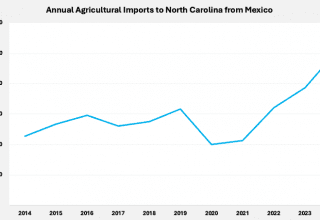As the Aug. 7 tariffs settle in, the Carolina Journal continues to analyze their impact on major North Carolina industries like agriculture and trade with major partners such as Mexico.
While Mexico was not included in the Aug. 7 tariffs, President Donald Trump did impose a 25% tariff on Mexico on March 4.
In 2024, Mexico emerged as the top export destination for US agricultural products, with sales exceeding $30 billion and supporting an estimated 190,000 American jobs, according to a USDA press release. Agricultural trade between the United States and Mexico under the United States-Mexico-Canada Agreement (USMCA) totaled nearly $79 billion that year, continuing a steady growth trend over the past decade.
Between 2014 and 2024, agricultural imports from Mexico to North Carolina rose sharply, climbing from $45.4 million to $100.8 million — an increase of approximately 122%, according to data from the North Carolina Department of Agriculture & Consumer Services (NCDA&CS). In 2024, the top three agricultural imports from Mexico were cigars and cigarettes made of tobacco or substitutes; edible vegetables and certain roots and tubers; and prepared cereals, flours, starches, or milk products, including baked goods.
During the same period, agricultural exports from North Carolina to Mexico remained relatively flat, from $224 million in 2014 to $241.3 million in 2024, a gain of just 8%, according to NCDA&CS data.
According to Harris, the leading agricultural exports to Mexico in 2024 included miscellaneous edible preparations — a broad category that ChatGPT notes covers items such as condiments, soups, protein powders, and processed foods — along with unmanufactured tobacco and tobacco refuse and manufactured tobacco products and related processed tobacco goods.

“Yet despite imports growing much faster than exports, exports are still more than double the value of imports, driven mainly by miscellaneous edible preparations, unmanufactured tobacco, and processed tobacco products,” Joseph Harris, fiscal policy analyst for the John Locke Foundation, told the Carolina Journal.
One exception to Trump’s 25% tariff on Mexico is Potash, a mineral commonly used in fertilizer, which was given a lower tariff rate of 10%.
“Through May 2025, agricultural imports from Mexico totaled $76.6 million, more than double the $35.8 million recorded by May 2024,” concluded Harris. “Much of this year-to-date surge likely reflects importers front-loading orders in anticipation of the tariffs taking effect.”
According to the USDA, the growth of US exports to Mexico is driven by several key factors, including increasing disposable income among Mexico’s upper-middle class, widespread recognition of US brands and food trends, and robust demand for premium agricultural products.
“Mexico is a long-valued trading partner with the United States, and I don’t see that changing,” Steve Troxler, commissioner of the NCDA&CS, told the Carolina Journal in a previous interview.
The post Despite hefty tariffs, trade with Mexico sees steady increase first appeared on Carolina Journal.
The post Despite hefty tariffs, trade with Mexico sees steady increase appeared first on First In Freedom Daily.
Click this link for the original source of this article.
Author: Katherine Zehnder
This content is courtesy of, and owned and copyrighted by, https://firstinfreedomdaily.com and its author. This content is made available by use of the public RSS feed offered by the host site and is used for educational purposes only. If you are the author or represent the host site and would like this content removed now and in the future, please contact USSANews.com using the email address in the Contact page found in the website menu.








